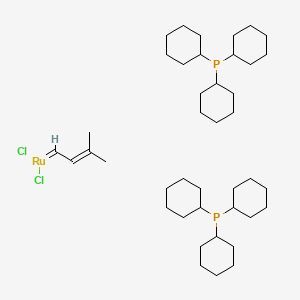Dichloro (3-methyl-2-butenylidene) bis(tricyclohexylphosphine) ruthenium (II)
Safety Information
Hazard Statements
Precautionary Statements
Pictograms
Product Description
Dichloro (3-methyl-2-butenylidene) bis(tricyclohexylphosphine) ruthenium (II) is a ruthenium-based metathesis catalyst, specifically designed for olefin cross-metathesis reactions. This compound combines the reactivity of ruthenium with the steric bulkiness of tricyclohexylphosphine ligands, which helps to control the reaction conditions and selectivity. Its structure is optimized for the formation of carbon-carbon double bonds, making it a powerful tool in the synthesis of complex organic molecules. The dichloro and bistricyclohexylphosphine ligands play crucial roles in stabilizing the active ruthenium species and facilitating the metathesis process.
Application
In practical applications, Dichloro (3-methyl-2-butenylidene) bis(tricyclohexylphosphine) ruthenium (II) is used in the synthesis of various organic compounds through olefin cross-metathesis. This includes the production of specialty chemicals, pharmaceuticals, and materials with unique properties. Its effectiveness in promoting efficient and selective metathesis reactions makes it invaluable in the chemical industry for the creation of complex molecules that are difficult to synthesize using traditional methods.
Articles:
- Concise Synthesis of (3Z)-Dodecen-12-olide, Pheromone Component of the Emerald Ash Borer
Publication Date: 29 May 2014
P. D. Mayo,P. J. Silk,D. I. MaGeeDeparment of Chemistry, University of New Brunswick, Fredericton, New Brunswick, Canada &J. McConaghy
https://doi.org/10.1080/00397911.2014.881497
- An Improved Synthesis of Ruthenium Metathesis Catalysts
Publication Date: January 2017
Authors: Agnieszka Hryniewicka, Marta Malinowska, Stanistaw Witkowski
